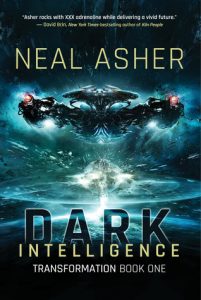Paul Di Filippo reviews Neal Asher
I have a sense that Neal Asher is much more popular in his native UK than he is here in the USA. Given the high quality of his appealing, innovative work, such an incongruity is hard to explain. I suspect that much of the difference might be attributed to a spotty publishing history here, with Asher novels being issued out of order; or not at all; or from an assortment of publishers; or falling out of print too fast. When twelve of your seventeen books form one massive series, that’s a problem.However, newbie Asher fans—and I myself have hardly read all his books—might have the perfect jumping-on place with Dark Intelligence, since it kicks off a whole new series and is Night Shade’s featured book in this month of its issuance, which argues for a concerted boost and support on their part.
The latest book is technically part of the extensive Polity series alluded to above. But from textual evidence, and from comparison to the useful future history posted by Asher himself, I’m guessing its internal chronology of events places it as, if not the ultimate book to date, probably the penultimate or antepenultimate. This means that all of the intricate future history events of the core titles are dead and gone in this timeframe (but not without lingering impact), and can be referenced simply as relevant backstory when necessary, and so we can start afresh.
Certainly our protagonist is starting afresh. He is Thorvald Spear, a dead man reanimated after a century of nonexistence. His essence was preserved during that time in a personality-storage gem, and then downloaded into a cloned body. (And by the way: remember when Greg Egan began to popularize this trope, and it needed massive explication and buttressing? Now it’s an off-the-shelf widget that can be deployed easily and without much hand-waving. And that’s how science fiction progresses!)
When he died, Thorvald was a military specialist, expert in the many complex cyber-bio-nano sciences of this era, all used for exotic bodily posthuman augmentations. He died in combat during the long war with the pradors, those vicious giant crabs who hate humanity. But the proximate cause of his death was the plotting of a rogue, or “Black,” Artificial Intelligence named Penny Royal.
Now, even though the prador war has been over for eighty years, Thorvald wants revenge on the machine brain. His plan involves rehabbing a salvaged Polity warship, and that brings him into the necessary orbit of one Isobel Satomi, a slave dealer and unprincipled outlaw for hire. The fact that Isobel’s augmented body, courtesy of Penny Royal, is deteriorating and mutating into a hideous new form—and that she thinks Thorvald can help her—constitute a basis for their temporary alliance.
But when Thorvald gets his ship, helmed by a disembodied prador brain named Flute, he discovers that his quest for revenge is just starting. Penny Royal is no longer where Isobel knew him to be, and the galaxy is a pretty big place, full of weird dangers and antagonists. And if a man can’t even trust his own memories…
What Asher delivers here is state-of-the-art SF on so many levels. First comes the milieu, akin to that post-scarcity scenario found variously in books by Iain Banks, Alistair Reynolds, Hannu Rajaniemi, Charles Stross, and Peter Hamilton. It’s a scenario that trembles on the edge of the Singularity while still being comprehensible to, and inhabitable by, the humans of the era and of course to us 21st-century dullards as well. Novelty and neologisms dominate nearly every page. Handled badly, such a strategy becomes confusing and frustrating. Asher does it well, though. And yet the reader needs to keep pace. There is just enough authorial guidance, but no condescending hand-holding. This type of SF is really the litmus test for separating serious readers from, say, media fans who might groove to Guardians of the Galaxy but blanch at A. E. van Vogt or John Wright, flavors of both of whom season Asher’s book.
It contained time crystals—cyclic quantum processes that required no input energy at all. It also used other processes to suck power from…the zero-point field. There were still other reactions…involving matter transmutation and the braking of the spin state of atoms.
The second realm in which this book delivers cutting edge speculations is its representation of the fluid boundaries of sapience, both human and alien. The book is not billed as the kickoff of the “Transformation” series for nothing. The primary characters enshrining this lesson are Isobel, who is turning into a predatory alien, and Sverl, a prador who is turning human—both through the intervention of Penny Royal.
“[He] was a prador unwilling being transformed into a joke of a human being. His whole carapace was taking on the shape of a human skull and it was softening, while that horrible and baffling tail was the rest of that disgusting soft creature. He surgically removed it but, over agonizing months, it grew back again.”
This kind of techno body horror, productive of “hopeful monsters,” has a small but potent lineage in SF, in such vehicles as the films Tetsuo: The Iron Man, Alien and Videodrome; Cordwainer Smith’s “A Planet Named Shayol;” and in a neglected masterpiece, Scott Westerfeld’s Evolution’s Darling. Asher’s contribution sets a new benchmark.
When you add in plenty of smart action, including several over-the-top space battles, as well as some inventive jumps between Thorvald’s first-person narration and the third-person viewpoints of other players, you get a compelling, smart read which makes one suspect that perhaps “Neal Asher” himself is merely an avatar for some dark intelligence!








